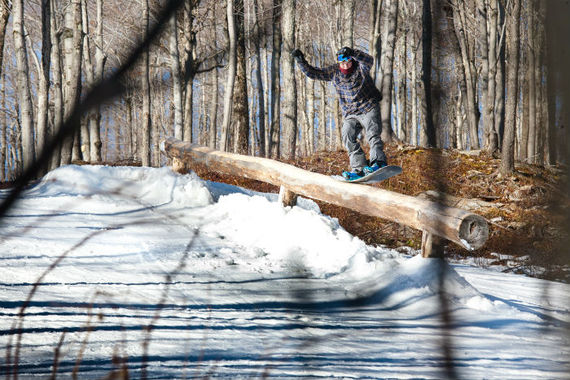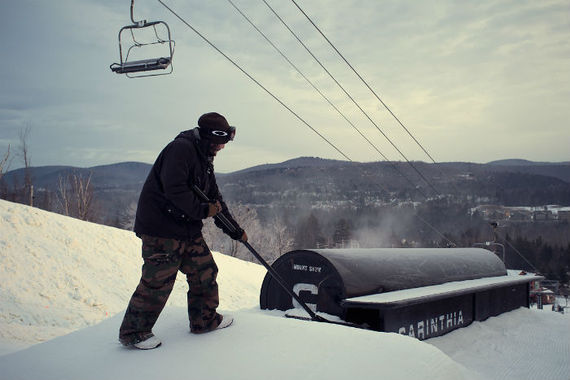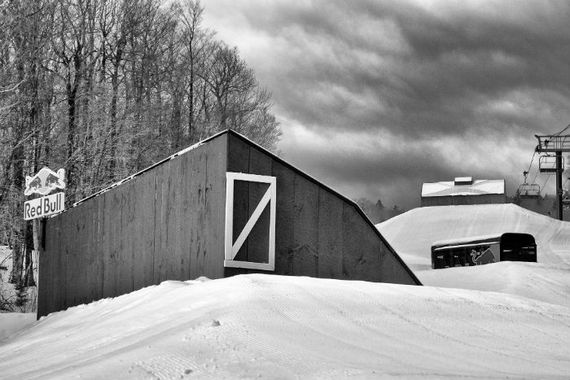Back in the dark ages of skiing, things were different. We rode dinosaurs to school (uphill both ways, of course), had to hike for all our turns, and if we wanted to get some air on our skis (snowboards did not exist), we had to find a rock or stump or build our own kicker.
Only one of those statements is actually true, but now that almost all ski areas have a terrain park, none of them is really the case anymore. You can find sweet rails, jumps, ramps, boxes, and more at most ski areas. These parks offer a relatively safe and controlled environment for jumping and doing tricks, and ski areas also offer some small, easy features in progression parks to get aspiring freeriders into the air for the first time. National Ski Areas Association studies indicate that 94% of ski areas have at least one terrain park, showing how popular they are. As well, about one in five visitors to the average ski area uses the terrain park on any given day.
To learn more about how terrain parks are conceived, constructed, and maintained, I spent some time with Day Franzen, freestyle terrain manager at Mount Snow. Carinthia Parks at Mount Snow has won numerous awards, including the Number One terrain park in the East in 2014, according to TransWorld Snowboarding and SKI Magazine. Mount Snow has a total of 8 different terrain parks, ranging from the beginner Grommet Park to the huge features in the Inferno Park. Their parks cover 100 acres of terrain and offer about 150 features total.
Terrain Park Construction
In the early part of the season, the focus of the terrain park construction is all about blowing snow. The snowguns crank out piles and piles of the white fluffy stuff, giving the grooming crew a base to bury the features in and material to build ramps and kickers. Franzen described how long each feature takes to build. "On average, a rail setup takes about an hour, and the average jump takes a couple of hours because we are moving more snow."
Carinthia's park crew consists of 12 people in the hand crew and 6 groomers. The hand crew works all day, from 7 a.m. to 5 p.m., "raking and dialing in all the features before opening and throughout the day", noted Franzen. Another part of their dawn patrol duties is putting the signs back up, which have to be removed each night for the grooming crew. The grooming crew work two shifts: 4 p.m. to midnight, and midnight to 8 a.m. The grooming and hand crews take great pride in their work of maintaining the parks and keeping the variety of features safe and exciting for varying ability levels.
Balancing Safety with Excitement
While today's terrain parks are a lot safer than just jumping off any old rock or kicker like we used to, they can still be dangerous places on the hill. Safety is extremely important when planning and building a terrain park. Having a well-designed set of features means that takeoff and landing angels are calculated and built with precision. Also, the flow between features can make or break the experience for a rider - features that are too close together or too far apart are evidence of an inexperienced park crew.
Balancing safety with excitement is the essence of building an awesome terrain park. "We look at the big picture. We look at every line and every option to assure it is as safe as we can make it while still being interesting," said Franzen about how to consider the tradeoffs of safety and challenge.
Every terrain park is unique in its features, flow, and layout. At Mount Snow, the jumps and rails are conceived by different members of the crew, based on their experience and their creativity. Many of the features are a collective effort from the whole team, often taking ideas from other parks and layering in signature features to make the experience different. For example, The Farm has a rural Vermont theme, with barns, a horse trailer, a sugar shack, and split rail fence.
Challenges
What are the biggest challenges in building and maintaining a terrain park? The snow, says Franzen. "The most difficult part is the conditions of snow. Snowmaking snow when first blown is easy to sculpt. Older piles are firm and require processing to achieve a good consistency. When it is huge chunks, we have to break them up to make the snow workable." Because the snow changes every day, keeping the terrain parks in world-class shape takes a lot of time and expense.
The most impressive part of well-designed terrain parks is the creativity and imagination that goes into some of the features. Even if you're not a freestyle rider, it's worth a lap through the terrain park at your local hill to check it out. You might see some impressive tricks on a unique hit or rail, and when you do, you can appreciate all the behind-the-scenes, hard work the park crew put in to make it all happen.
By Dave Belin / @Rrcdave


